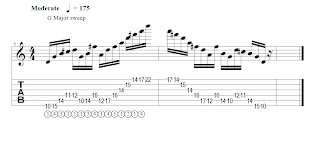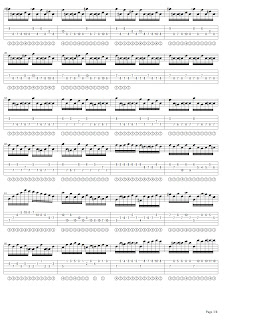I - Ionian - 1, 2, 3, 4, 5, 6, 7 (M7) *(Alterations are based on the major scale)*
II - Dorian - 1, 2, b3, 4, 5, 6, b7 (m7)
III - Phrygian - 1, b2, b3, 4, 5, b6, b7 (m7)
IV - Lydian - 1, 2, 3, #4, 5, 6, 7 (M7)
V - Mixolydian - 1, 2, 3, 4, 5, 6, b7 (7)
VI - Aeolian - 1, 2, b3, 4, 5, b6, b7 (Natural minor scale) (m7)
VII - Locrian - 1, b2, b3, 4, b5, b6, b7 (m7b5)
Now I'll write out the tensions for the Melodic and Harmonic minor modes. The tablature provided also has the chords and a few chord-melody examples for the two modes. The Melodic minor is actually just the major scale with a flatted 3rd but obviously it creates a hugely different feel over the course of 6 additional scales. The Harmonic minor is exactly like the Aeolian mode but has a raised or natural 7th.
I - Melodic Minor - 1, 2, b3, 4, 5, 6, 7
II - Dorian b2 - 1, b2, b3, 4, 5, 6, b7
III - Lydian Augmented - 1, 2, 3, #4, #5, 6, 7
IV - Lydian Dominant - 1, 2, 3, #4, 5, 6, b7
V - Hindu/Mixolydian b6 - 1, 2, 3, 4, 5, b6, b7
VI - Locrian natural 2/Aeolian b5 - 1, 2, b3, 4, b5, b6, b7
VII - Super Locrian - 1, b2, b3, b4, b5, b6, b7
I - Harmonic Minor - 1, 2, b3, 4, 5, b6, 7
II - Locrian #6 - 1, b2, b3, 4, b5, 6, b7
III - Ionian #5 - 1, 2, 3, 4, #5, 6, 7
IV - Dorian #4 - 1, b2, b3, #4, 5, 6, b7
V - Phrygian #3 - 1, b2, 3, 4, 5, b6, b7
VI - Lydian #2 - 1, #2, 3, #4, 5, 6, 7
VII - Altered bb7 - 1, b2, b3, b4, b5, b6, bb7

 There are many more scales that make great and usable modes: the Harmonic major, Neopolitan major/minor, Hungarian major/minor, etc. I'll get around to posting those ones soon enough.
There are many more scales that make great and usable modes: the Harmonic major, Neopolitan major/minor, Hungarian major/minor, etc. I'll get around to posting those ones soon enough.






























































